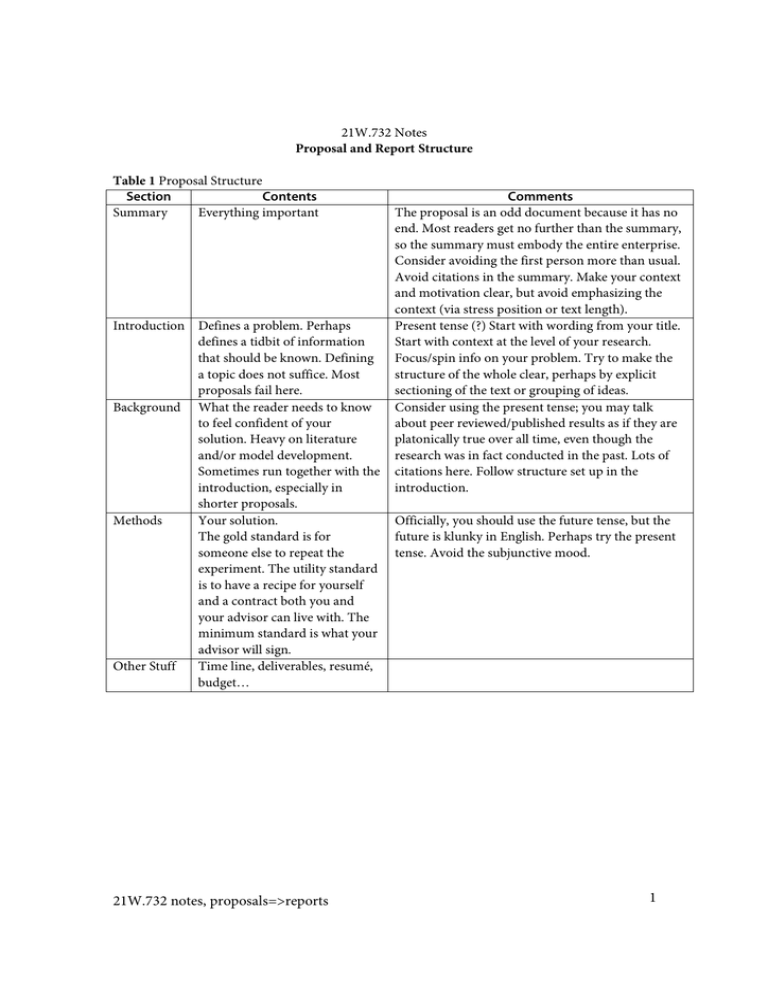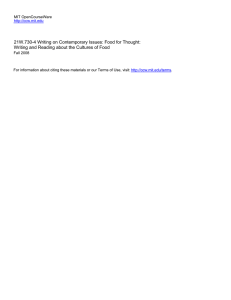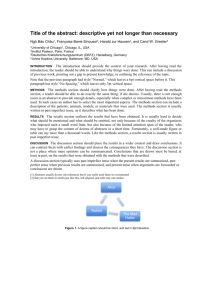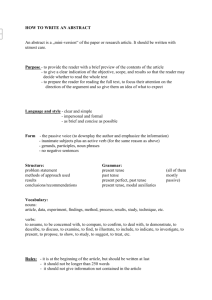21W.732 Notes Proposal Structure Summary Everything important
advertisement

21W.732 Notes Proposal and Report Structure Table 1 Proposal Structure Section Contents Summary Everything important Introduction Defines a problem. Perhaps defines a tidbit of information that should be known. Defining a topic does not suffice. Most proposals fail here. Background What the reader needs to know to feel confident of your solution. Heavy on literature and/or model development. Sometimes run together with the introduction, especially in shorter proposals. Methods Your solution. The gold standard is for someone else to repeat the experiment. The utility standard is to have a recipe for yourself and a contract both you and your advisor can live with. The minimum standard is what your advisor will sign. Other Stuff Time line, deliverables, resumé, budget… 21W.732 notes, proposals=>reports Comments The proposal is an odd document because it has no end. Most readers get no further than the summary, so the summary must embody the entire enterprise. Consider avoiding the first person more than usual. Avoid citations in the summary. Make your context and motivation clear, but avoid emphasizing the context (via stress position or text length). Present tense (?) Start with wording from your title. Start with context at the level of your research. Focus/spin info on your problem. Try to make the structure of the whole clear, perhaps by explicit sectioning of the text or grouping of ideas. Consider using the present tense; you may talk about peer reviewed/published results as if they are platonically true over all time, even though the research was in fact conducted in the past. Lots of citations here. Follow structure set up in the introduction. Officially, you should use the future tense, but the future is klunky in English. Perhaps try the present tense. Avoid the subjunctive mood. 1 If your proposal is well written and if your research goes as you expect, your proposal should appear word for word in your report. Table 1 Report Structure Section Contents Abstract Theses have abstracts. Abstracts have 4 pieces of information: problem, solution, results, & conclusion. If you must, include half a sentence of context information, especially if your audience is varied or your work interdisciplinary. Introduction Defines a problem. A topic does not suffice. Background What the reader needs to know to feel confident of your solution. Heavy on literature and/or model development Methods Your solution. The gold standard is for someone else to repeat the experiment. While this section is the “story” of your research, consider other structures that are more important to your ideas than the ordering of your research in time. Avoid dwelling on thing you did that did not work. Results What happened when you did what you did. Discussion I abhor the word “discuss.” Think “analysis.” Conclusion The big synthesis. Comments Often the sentences are long and difficult to parse. Avoid citations in the abstract as many readers will not have access to your bibliography. Possible word for word inclusion from proposal. Try to set up a structure from the start. Possible word for word inclusion from proposal. Keep the reader aware of the structure via sections & headings (throughout the thesis). Officially, probably use the past tense for your work, which is not yet peer reviewed and may not be found true over all time. Possible word for word ± tense changes. Perhaps try the present tense. Avoid overusing multiple verbs tenses to express different eras of your research. “Data had been derived from estimators before the onset of singularities occurred. Then unusual circumstances were being driven by strange attractors while our lunch was delivered. Any conclusions will have been drawn from a hat.” Past tense, like your methods. The results section may be very low on text for folks with quantitative or graphical results. Sometimes the results and discussion sections are combined. Sometimes discussion and conclusion are combined. Sometimes all three are lumped into one section, especially in shorter reports. Consider starting with a sentence that restates your problem, along the lines of “We set out to solve problem X.” I have omitted many parts: cover page, table of contents, lists of stuff, bibliography…. 21W.732 notes, proposals=>reports 2 MIT OpenCourseWare http://ocw.mit.edu 21W.732 / ESG.21W732 Science Writing and New Media Fall 2010 For information about citing these materials or our Terms of Use, visit: http://ocw.mit.edu/terms.



